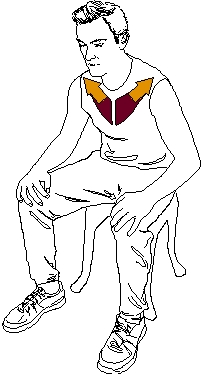A) They retract the cervical spine to open the airway.
B) They are not active during quiet ventilation.
C) They laterally flex the cervical spine.
D) They lift the first two ribs and sternum.
Correct Answer

verified
Correct Answer
verified
Multiple Choice
Which lung volume represents the air moving in and out of the lungs during quiet ventilation?
A) Expiratory reserve volume
B) Tidal volume
C) Inspiratory reserve volume
D) Residual volume
Correct Answer

verified
Correct Answer
verified
Multiple Choice
Which of the following statements BEST describes the movement of ribs 2-7 and the sternum during inspiration?
A) Sternum moves ventrally, ribs move in sagittal plane increasing anterior/posterior diameter
B) Ribs lift up and outward in the frontal plane
C) Little movement of the ribs occurs during ventilation
D) Sternum moves inferiorly, ribs move anteriorly and laterally
Correct Answer

verified
Correct Answer
verified
Multiple Choice
What is the innervation of the diaphragm muscle?
A) C6-T4, phrenic nerve
B) T7-T12, intercostal nerves
C) C3-C5, phrenic nerve
D) T1-T6, intercostal nerves
Correct Answer

verified
Correct Answer
verified
Multiple Choice
 -Which of the following statements BEST describes the muscle function as depicted by the arrows in the image?
-Which of the following statements BEST describes the muscle function as depicted by the arrows in the image?
A) Sternocleidomastoid pulls the sternum toward the humerus to assist with inspiration
B) Sternocleidomastoid pulls the sternum toward the humerus to assist with expiration
C) Pectoralis major pulls the sternum toward the humerus to assist with inspiration
D) Pectoralis major pulls the sternum toward the humerus to assist with expiration
Correct Answer

verified
Correct Answer
verified
Multiple Choice
What factors are involved with increasing the energy requirements of breathing as people age?
A) Decrease in cross-links in collagen fibers of connective tissues
B) Decrease in residual lung volumes
C) Decrease in rib calcification
D) Decrease in chest wall mobility, change in spinal curves, alveoli thickening
Correct Answer

verified
Correct Answer
verified
Multiple Choice
Which lung volume represents the air remaining in the lungs after maximal expiration?
A) Expiratory reserve volume
B) Tidal volume
C) Inspiratory reserve volume
D) Residual volume
Correct Answer

verified
Correct Answer
verified
Multiple Choice
Which muscle(s) serves(serve) as the primary ventilatory muscle during quiet inspiration?
A) Scalenes
B) Diaphragm
C) Intercostals
D) Rectus abdominis
Correct Answer

verified
Correct Answer
verified
Multiple Choice
What is the function of the scalene muscles during quiet ventilation?
A) They retract the cervical spine to open the airway.
B) They are not active during quiet ventilation.
C) They laterally flex the cervical spine.
D) They lift the first two ribs and sternum.
Correct Answer

verified
Correct Answer
verified
Multiple Choice
Which of the following lung volumes represents the vital capacity of the lungs?
A) Residual, expiratory reserve, tidal volume
B) Inspiratory reserve, expiratory reserve, tidal volume
C) Expiratory reserve, tidal, residual volume
D) Residual, inspiratory reserve, tidal volume
Correct Answer

verified
B
Correct Answer
verified
Multiple Choice
Which of the following factors are associated with quiet ventilation?
A) Decreased metabolic demands, decreased rate and depth of ventilation
B) Decreased metabolic demands, increased rate and depth of ventilation
C) Increased metabolic demands, decreased rate and depth of ventilation
D) Increased metabolic demands, increased rate and depth of ventilation
Correct Answer

verified
Correct Answer
verified
Multiple Choice
Which ribs form the costovertebral joints?
A) 2-12
B) 2-7
C) 1-12
D) 5-10
Correct Answer

verified
Correct Answer
verified
Multiple Choice
Which ribs form the costotransverse joints?
A) 1-10
B) 2-7
C) 1-12
D) 5-10
Correct Answer

verified
Correct Answer
verified
Multiple Choice
Which of the following bony structures form the thorax?
A) Cervicothoracic vertebrae, ribs, sternum
B) Cervical vertebrae, ribs, sternum
C) Thoracic vertebrae, ribs, sternum
D) Thoracolumbar vertebrae, ribs, sternum
Correct Answer

verified
Correct Answer
verified
Multiple Choice
Which of the following statements BEST describes the function of the diaphragm during deep inspiration?
A) Dome of diaphragm descends, lifts upper ribs increasing anterior/posterior diameter of thorax
B) Dome of diaphragm descends, increases vertical thorax diameter, lifts lower ribs up and outward
C) Dome of diaphragm ascends, decreases vertical thorax diameter, lifts lower ribs up and outward
D) Dome of diaphragm ascends, lifts upper ribs increasing anterior/posterior diameter of thorax
Correct Answer

verified
B
Correct Answer
verified
Multiple Choice
Which lung volume represents the air moving in the lungs during deep breathing?
A) Expiratory reserve volume and tidal volume
B) Tidal volume
C) Inspiratory reserve volume and tidal volume
D) Residual volume
Correct Answer

verified
Correct Answer
verified
Multiple Choice
Which of the following factors are associated with forced ventilation?
A) Decreased metabolic demands, decreased rate and depth of ventilation
B) Decreased metabolic demands, increased rate and depth of ventilation
C) Increased metabolic demands, decreased rate and depth of ventilation
D) Increased metabolic demands, increased rate and depth of ventilation
Correct Answer

verified
Correct Answer
verified
Multiple Choice
Which of the following statements BEST describes the kinematics of expiration during regular breathing in healthy people?
A) Diaphragm contracts resulting in passive movement of air out of lungs
B) Diaphragm relaxes, increases thoracic volume, decreasing lung pressure
C) Diaphragm contracts, decreases thoracic volume, pushing air out of lungs
D) Diaphragm relaxes, increases intrapulmonary pressure, resulting in passive movement of air out
Correct Answer

verified
Correct Answer
verified
Multiple Choice
 -Which of the following statements BEST describes forced expiration?
-Which of the following statements BEST describes forced expiration?
A) An active process requiring contraction of abdominal muscles
B) A passive process as the diaphragm contracts
C) A passive process requiring contraction of abdominal muscles
D) An active process as the abdominal muscles and diaphragm contract
Correct Answer

verified
A
Correct Answer
verified
Multiple Choice
Which lung volume represents the air moving out of the lungs after quiet expiration?
A) Expiratory reserve volume
B) Tidal volume
C) Inspiratory reserve volume
D) Residual volume
Correct Answer

verified
Correct Answer
verified
Showing 1 - 20 of 20
Related Exams